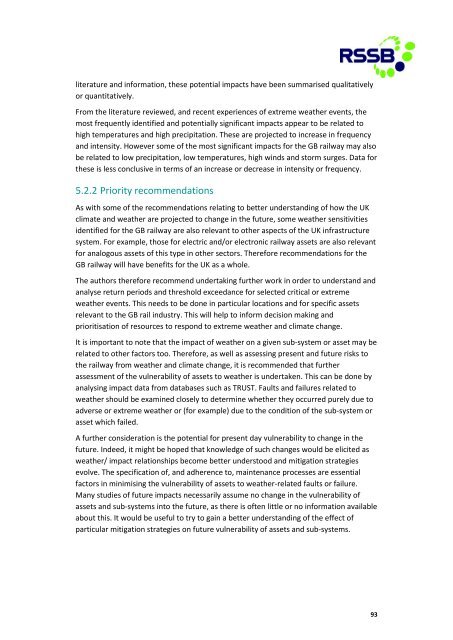Tomorrow's Railway and Climate Change Adaptation Final Report
2016-05-T1009-final-report
2016-05-T1009-final-report
Create successful ePaper yourself
Turn your PDF publications into a flip-book with our unique Google optimized e-Paper software.
literature <strong>and</strong> information, these potential impacts have been summarised qualitatively<br />
or quantitatively.<br />
From the literature reviewed, <strong>and</strong> recent experiences of extreme weather events, the<br />
most frequently identified <strong>and</strong> potentially significant impacts appear to be related to<br />
high temperatures <strong>and</strong> high precipitation. These are projected to increase in frequency<br />
<strong>and</strong> intensity. However some of the most significant impacts for the GB railway may also<br />
be related to low precipitation, low temperatures, high winds <strong>and</strong> storm surges. Data for<br />
these is less conclusive in terms of an increase or decrease in intensity or frequency.<br />
5.2.2 Priority recommendations<br />
As with some of the recommendations relating to better underst<strong>and</strong>ing of how the UK<br />
climate <strong>and</strong> weather are projected to change in the future, some weather sensitivities<br />
identified for the GB railway are also relevant to other aspects of the UK infrastructure<br />
system. For example, those for electric <strong>and</strong>/or electronic railway assets are also relevant<br />
for analogous assets of this type in other sectors. Therefore recommendations for the<br />
GB railway will have benefits for the UK as a whole.<br />
The authors therefore recommend undertaking further work in order to underst<strong>and</strong> <strong>and</strong><br />
analyse return periods <strong>and</strong> threshold exceedance for selected critical or extreme<br />
weather events. This needs to be done in particular locations <strong>and</strong> for specific assets<br />
relevant to the GB rail industry. This will help to inform decision making <strong>and</strong><br />
prioritisation of resources to respond to extreme weather <strong>and</strong> climate change.<br />
It is important to note that the impact of weather on a given sub-system or asset may be<br />
related to other factors too. Therefore, as well as assessing present <strong>and</strong> future risks to<br />
the railway from weather <strong>and</strong> climate change, it is recommended that further<br />
assessment of the vulnerability of assets to weather is undertaken. This can be done by<br />
analysing impact data from databases such as TRUST. Faults <strong>and</strong> failures related to<br />
weather should be examined closely to determine whether they occurred purely due to<br />
adverse or extreme weather or (for example) due to the condition of the sub-system or<br />
asset which failed.<br />
A further consideration is the potential for present day vulnerability to change in the<br />
future. Indeed, it might be hoped that knowledge of such changes would be elicited as<br />
weather/ impact relationships become better understood <strong>and</strong> mitigation strategies<br />
evolve. The specification of, <strong>and</strong> adherence to, maintenance processes are essential<br />
factors in minimising the vulnerability of assets to weather-related faults or failure.<br />
Many studies of future impacts necessarily assume no change in the vulnerability of<br />
assets <strong>and</strong> sub-systems into the future, as there is often little or no information available<br />
about this. It would be useful to try to gain a better underst<strong>and</strong>ing of the effect of<br />
particular mitigation strategies on future vulnerability of assets <strong>and</strong> sub-systems.<br />
93


